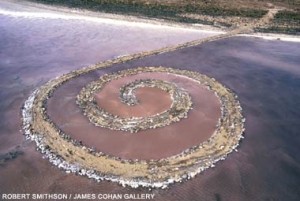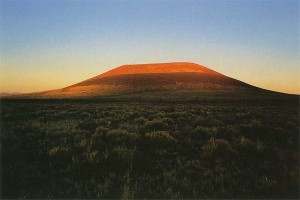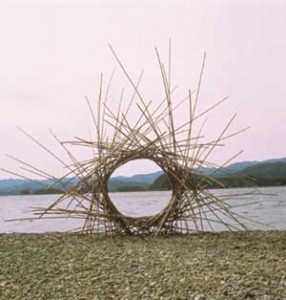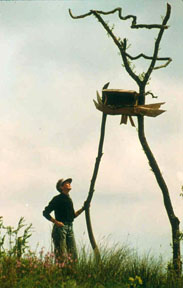 The relationship between art and nature may not be apparent to everyone, but art and the environment have been linked together as far back as the days of Plato and Aristotle when aesthetics was connected to the beauty of our surrounding and the natural world. Much of the artwork created around this time period had to do with flora. As time progressed landscape painting became the most obvious way to portray natural aesthetic beauty. As history continued to move forward so too did the relationship between art and nature. Artists in the late 19th century no longer painted from sketches of the landscape, but instead immersed themselves in the environment by painting in the outdoors. This style became known as en plein air.
The relationship between art and nature may not be apparent to everyone, but art and the environment have been linked together as far back as the days of Plato and Aristotle when aesthetics was connected to the beauty of our surrounding and the natural world. Much of the artwork created around this time period had to do with flora. As time progressed landscape painting became the most obvious way to portray natural aesthetic beauty. As history continued to move forward so too did the relationship between art and nature. Artists in the late 19th century no longer painted from sketches of the landscape, but instead immersed themselves in the environment by painting in the outdoors. This style became known as en plein air.
 In the 1960s a further change in the bond between art and the earth emerged. Instead of replicating the landscape or environment from which they were a part of, artists took their work into the environment by creating art that became known as Earth Art or Land Art. This type of art literally works with the environment by creating pieces that exist in the landscape and/or using natural materials. The most popular piece created during this time is Robert Smithson’s Spiral Jetty, which juts out into the Great Salt Lake.
In the 1960s a further change in the bond between art and the earth emerged. Instead of replicating the landscape or environment from which they were a part of, artists took their work into the environment by creating art that became known as Earth Art or Land Art. This type of art literally works with the environment by creating pieces that exist in the landscape and/or using natural materials. The most popular piece created during this time is Robert Smithson’s Spiral Jetty, which juts out into the Great Salt Lake.
 Today artists have pushed the boundary even further. Much of the contemporary arts society that deals with Earth Art pertains to the survival of the environment or making people aware of it. Many artists work in the outdoors using natural materials that will degrade over time. Most commonly known is Andy Goldsworthy. However, there are many more artists who create similar and greater artworks within the landscape. Lynne Hull is an artist who builds artistic habitats in areas where the original habitat is or has been destroyed due to human impact. James Turrell has been building Roden Crater, which is a massive man-made crater located in Arizona, for over two decades, and although Turrell’s work is not directed toward environmental awareness, its intention is to stimulate a physical and visual experience between the viewer and landscape.
Today artists have pushed the boundary even further. Much of the contemporary arts society that deals with Earth Art pertains to the survival of the environment or making people aware of it. Many artists work in the outdoors using natural materials that will degrade over time. Most commonly known is Andy Goldsworthy. However, there are many more artists who create similar and greater artworks within the landscape. Lynne Hull is an artist who builds artistic habitats in areas where the original habitat is or has been destroyed due to human impact. James Turrell has been building Roden Crater, which is a massive man-made crater located in Arizona, for over two decades, and although Turrell’s work is not directed toward environmental awareness, its intention is to stimulate a physical and visual experience between the viewer and landscape.
 Female artist Reiko Goto often works with Tim Collins to create large-scale environmental projects alerting urban populations to changes in waterfronts within specific locations. On an even larger scale, Revival Field is an on-going project created by Mel Chin, in which plants are used to remove toxic metals from soil. Furthermore, Chin’s work crosses boundaries between environmental awareness and social awareness as seen in his most recent work known as the fundred project; through extensive research and his own giving, Chin is solving a way to remove lead from the soil in some of the country’s most highly lead-populated areas such as New Orleans and Oakland, CA. This project is open to anyone willing to participate across the United States.
Female artist Reiko Goto often works with Tim Collins to create large-scale environmental projects alerting urban populations to changes in waterfronts within specific locations. On an even larger scale, Revival Field is an on-going project created by Mel Chin, in which plants are used to remove toxic metals from soil. Furthermore, Chin’s work crosses boundaries between environmental awareness and social awareness as seen in his most recent work known as the fundred project; through extensive research and his own giving, Chin is solving a way to remove lead from the soil in some of the country’s most highly lead-populated areas such as New Orleans and Oakland, CA. This project is open to anyone willing to participate across the United States.
 These are just a few selected artists who are finding ways to incorporate the land and environment into their artwork. Unlike the relationship between the two from centuries before, today’s Land Art and Earth Art examines the correlation between science and art as well. As said in an article by M. Branagan, “The arts greatly benefit environmental education, through their ability to communicate complex information in simple but powerful ways,” therefore pushing the boundary and relationship between art and the environment even further into the future. Preserving our planet is important, but it is also important to find alternative ways to reach such a great and diverse population. Bringing art into the environmental or outdoor “classroom” is just one of many ways to reach students.
These are just a few selected artists who are finding ways to incorporate the land and environment into their artwork. Unlike the relationship between the two from centuries before, today’s Land Art and Earth Art examines the correlation between science and art as well. As said in an article by M. Branagan, “The arts greatly benefit environmental education, through their ability to communicate complex information in simple but powerful ways,” therefore pushing the boundary and relationship between art and the environment even further into the future. Preserving our planet is important, but it is also important to find alternative ways to reach such a great and diverse population. Bringing art into the environmental or outdoor “classroom” is just one of many ways to reach students.
To learn more about the artists and projects mentioned or new artists and Earth/Land Art please use the following resources:
Websites:
Fundred Project: http://www.fundred.org/
James Turrell: http://www.pbs.org/art21/artists/james-turrell
Mark Dion and Ecology: http://www.pbs.org/art21/films/ecology
Mel Chin: http://www.pbs.org/art21/artists/mel-chin ; http://www.melchin.org/
Robert Smithson: http://www.robertsmithson.com/
Various Artists: http://greenmuseum.org/
Books:
Art in the Landscape
A Sense of Wonder, R. Carson
Land Art, M. Lailach
Land Art, B. Tufnell
Mapping the Terrain, L. Lippard
The Reenchantment of Art, S. Gablik
At High Trails Outdoor Science School, we literally force our instructors to write about elementary outdoor education, teaching outside, learning outside, our dirty classroom (the forest…gosh), environmental science, outdoor science, and all other tree hugging student and kid loving things that keep us engaged, passionate, driven, loving our job, digging our life, and spreading the word to anyone whose attention we can hold for long enough to actually make it through reading this entire sentence. Whew…. www.dirtyclassroom.com

Comments are closed.